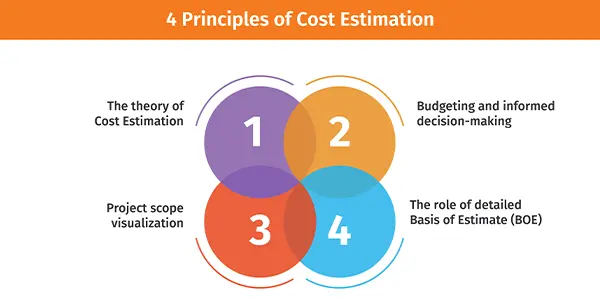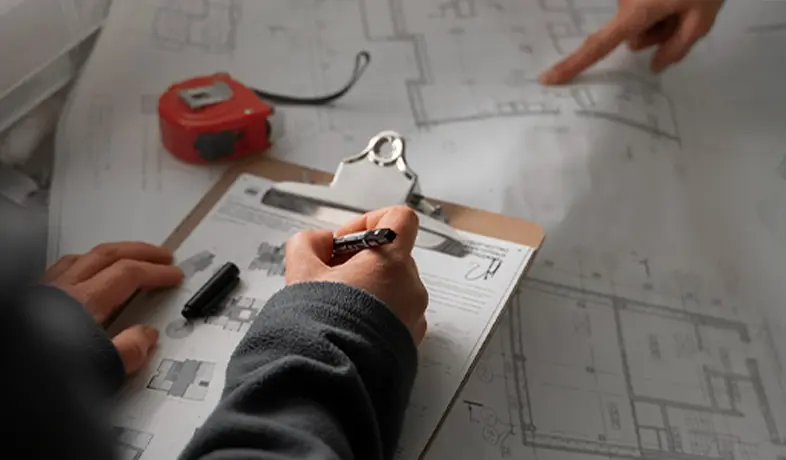
This guide will walk you through the critical aspects of cost estimation, including key principles, the importance of accurate estimates, and real-world examples for different types of projects.
Cost Estimation in Project Management
Cost estimation in project management is the process of forecasting the cost and resources needed to complete a project within a defined scope. Cost estimation accounts for each element required for the project and estimates a total amount that determines a project’s budget.
In project management, estimating typically generates all the cost data for the project. Project estimates progress through several levels, each with increasing detail and accuracy. As the project scope becomes more defined, the cost estimates become more refined.
However, you should keep in mind that a good estimate includes not only the cost but also all data related to the way the project was envisioned to be carried out.
4 Principles of Cost Estimation

1) The theory of cost estimation
Cost estimation is used to predict the quantity, cost and price of the resources required by the scope of a project. A project is any process started to perform work activities and/or create assets to create a business case. The accuracy of the estimate depends heavily on the level of project scope definition. As the design and conditions of the project become better defined, so do the estimated values.
2) Cost estimation for budgeting and informed decision making
Cost estimation is necessary to enable decision-makers to make investment decisions, choose between alternatives, and establish the budget during the front end of projects. Additionally, clients need to validate estimates provided by vendors and contractors as well. Later phases of the project utilize the budget estimate as a baseline to evaluate project performance.
Related to this principle, it is always challenging to collect and read the huge amount of cost data, which doesn’t help with the decision making. Analyzing and visualizing the cost data opens the doors to making the data useful and meaningful. Estimating software and project controls system dashboards are data-driven graphical representations of a project. They offer decision-makers a quick overview of a project’s level of definition or even actual progress and convert data into actionable decision points.
3) Project scope visualized in various reporting structures
Estimating involves breaking down the total scope of a project into manageable parts, assigning resources, and determining costs. In other words, we are using breakdown structures to visualize the estimate in a way that meets the reporting needs of stakeholders. There are several standardized ways of breaking down a project such as the Work Breakdown Structure (WBS), the Cost Breakdown Structure (CBS), and the Resource Breakdown Structure (RBS). However, project teams and external parties often implement multiple breakdown structures to align reporting and sharing of cost data depending on their needs.
4) The role of a Detailed Basis of Estimate (BOE)
A cost estimate is more than a list of costs. The estimate should include a detailed Basis of Estimate (BOE) report that describes the assumptions, inclusions, exclusions, accuracy, and other aspects necessary to interpret the total project cost. Otherwise, it would be a meaningless number.
The BOE is necessary to communicate the estimate to the various parties involved in decision-making. Furthermore, it is also handy during closeout when comparing the performance of the project with other projects. Despite its vital role in learning from experience and mistakes, project teams often overlook it.
By keeping these 4 principles in mind, you already have a framework to start creating estimates. Make sure to set up the estimate in a structured way to allow for an easy transition into project cost estimating software.
Why Cost Estimation is Important
Investing time and effort in accurate cost estimation early on not only helps save time and money, or select the most profitable project but also ensures smoother project controls management. It’s a critical practice for driving transparency, minimizing risks, and ensuring overall project success.
Solid project planning: Converts project scope into actionable deliverables, aligning resources for clear timelines, budgeting, and task allocation.
Improved resource allocation: Optimizes resource use, preventing shortages or under-utilization while supporting better staffing and equipment decisions.
Accurate budgeting and control: Ensures projects start with a well-substantiated budget, reducing unforeseen costs and enabling efficient allocation of money, time, and resources.
Risk mitigation: Cost estimation identifies potential risks early, enabling the inclusion of contingency reserves to address “unforeseen” challenges and prevent cost overruns.
Competitive bidding: For companies involved in bidding or contracts, precise cost estimates improve competitiveness and credibility, increasing the chances of winning projects.
Project transparency: Accurate cost and labor norms data improves communication and collaboration among teams and clients, ensuring alignment throughout the project.
Key Considerations in Project Cost Estimation
In most cases, project teams complete this exercise early in the project lifecycle, obtain the approved for expenditure (AFE) funds, and promptly file and forget all that data.
In the early stages of the project, project teams apply various methods to develop estimates based on available data. This includes capacity factoring, equipment factoring and parametric estimating.
In most cases, the project then advances to its execution phase, and the team selects the best path forward. However, they often neglect the differences between this execution path and the path envisioned during budget creation, which constitutes the estimate.
Using a project cost management system, such as a software tool, that integrates all project control units makes it impossible to ignore execution changes after baselining the budget from the estimating data. This is because the data remains consistent. The inherent structure of the software compels it to highlight and clearly distinguish any alterations from the baseline. Consequently, the cost estimate automatically updates with execution changes, ensuring the project estimate remains dynamic and accurate.
3 Cost Estimate Examples for Different Projects
Consider the 3 following projects:
Project 1
- Cost estimate : $ 231,500,000
- Actual outcome : $ 234,244,600
Project 2
- Cost estimate : $ 45,800,000
- Actual outcome : $ 53,950,000
Project 3
- Cost estimate : $ 100,000,000
- Actual outcome : $ 77,428,000
How to compare project estimates?

‘For which project did we deliver the most accurate, and thereby the best project estimate?’
Mind you, this is often the only information that is communicated. Therefore, you might be tempted to say that cost estimate 1 is the most accurate one. The first question you should ask is: are we comparing apples to apples? Let’s see:
Estimate 1 is a Final Funding Estimate on chemical production facility (AACE Class 3 estimate). It shows a difference between the actual cost of +1.2%. However, after the cost estimate was approved, a number of scope changes were introduced: two storage tanks were removed, including the associated civil, piping, electrical and instrument costs. Additionally, the truck loading area was reduced from 4 to 2 bays. This all contributed to a reduction in scope of $ 55M. As a result, the difference between the estimated and actual cost of the project is +25%.
Estimate 2 is a Class 3 estimate as well, for a hotel resort, to which scope was added after estimate approval: improved quality finishing and additional landscaping. This contributed to an effective difference of +13% between estimated and actual cost.
Estimate 3 is only a screening estimate for the expansion of a refinery. The difference between estimated and actual cost amounts to -22%. However, this is considered to be a much less accurate AACE Class 5 estimate. Even more, after the overall capacity increase, the difference became even less.
Takeaway from the cost estimate examples

The cost estimate examples show that the last estimate might have seemed the least accurate one, but it is actually pretty good. According to the AACE International Recommended Practice 18R-97, the Class 5 estimate was considered to be between +/- 50% of the actual outcome, which was achieved. The Class 3 estimates were supposed to be reported within +/- 15% of the actual project outcome, which estimate 1 did not achieve and estimate 2 only by a small margin. This is why you always must make sure you are comparing apples to apples!
These examples emphasize the importance of comparing estimates within their appropriate classification levels. Always keep in mind AACE’s classification system, which provides a standardized way to set and evaluate accuracy expectations based on project maturity.
Different Types of Cost Estimates (5 Classes)

There are 5 classes of estimates based on AACE’s recommended practice 18R-97:
Class 5 estimate: These rough order of magnitude (ROM) estimates are used in the early stages of project planning and are based on limited information. They are typically used for scenario analysis.
Class 4 estimate: These conceptual estimates are slightly more detailed than Class 5 estimates and can be developed when the project matures, and some basic engineering deliverables are available (equipment list, plot plan). Class 4 estimates are used to assess project feasibility.
Class 3 Estimate: These estimates can be developed when basic engineering is done and they are used for budget authorization and FID.
Class 2 estimate: Class 2 estimates can be developed when detailed engineering documentation is available (MTOs, proposals/Pos…) and they are used for cost control and bidding.
Class 1 estimates: Class 1 estimates can be developed in close consultation with your contractors/EPC and subcontractors. Class 1 is the most detailed estimate available.
Estimate your costs with Cleopatra Enterprise
Cost estimation can make or break a project and using the right tools in combination with solid cost and labor norm data can significantly impact the accuracy, efficiency, and overall success of your estimates. By leveraging a cost estimating software like Cleopatra Enterprise, you can streamline the creation of estimates across all five AACE classes, ensuring consistency, improved estimate accuracy, and adaptability as your project evolves. Please note that Cleopatra Enterprise is also able to work with other estimation classification systems.
In the world of software, there’s hardly any tool that is more hated and loved at the same…
What is Project Cost Management? A definition Project cost management focuses on finding the right project and carrying…
Related resources
5 cost estimation techniques supported by Cleopatra's software
Learn which project cost estimating techniques you can apply with an advanced software tool to develop more accurate cost estimates for your projects.
Learn which project cost estimating techniques you can apply with an advanced software tool to develop more accurate…
Read blog articleResource-Based vs Activity-Based Estimating Software
The pros and cons of Resource based estimating and activity based estimating.
The pros and cons of Resource based estimating and activity based estimating.
Read blog articleCost overruns in projects: meaning, causes, and how to prevent them
Discover the top 5 reasons for project cost overruns, a practical checklist to prevent them, and expert strategies to manage overruns effectively.
Discover the top 5 reasons for project cost overruns, a practical checklist to prevent them, and expert strategies…
Read blog articleParametric estimating in project management
Parametric estimating for estimating projects is a technique that involves using mathematical relationships and statistical analysis to develop cost estimates based on a set of parameters or variables. Instead of relying solely on engineering input or detailed project specifications, it leverages the relationship between various project characteristics to derive cost…
Parametric estimating for estimating projects is a technique that involves using mathematical relationships and statistical analysis to develop…
Read blog article


